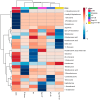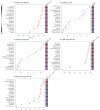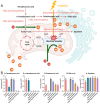Development and Metabolomic Profiles of Bactrocera dorsalis (Diptera: Tephritidae) Larvae Exposed to Phytosanitary Irradiation Dose in Hypoxic Environment Using DI-SPME-GC/MS
- PMID: 38535372
- PMCID: PMC10971714
- DOI: 10.3390/insects15030177
Development and Metabolomic Profiles of Bactrocera dorsalis (Diptera: Tephritidae) Larvae Exposed to Phytosanitary Irradiation Dose in Hypoxic Environment Using DI-SPME-GC/MS
Abstract
X-ray irradiation and modified atmospheres (MAs) provide eco-friendly, chemical-free methods for pest management. Although a low-oxygen atmospheric treatment improves the performance of some irradiated insects, its influence on the irradiation of quarantine insects and its impacts on pest control efficacy have yet to be investigated. Based on bioassay results, this study employed direct immersion solid-phase microextraction (DI-SPME) combined with gas chromatography-mass spectrometry (GC-MS) to determine metabolic profiles of late third-instar B. dorsalis larvae under normoxia (CON, Air), hypoxia (95% N2 + 5% O2, HY), super-hypoxia (99.5% N2 + 0.5% O2, Sup-HY), irradiation-alone (116 Gy, IR-alone), hypoxia + irradiation (HY + IR) and super-hypoxia + irradiation (Sup-HY + IR). Our findings reveal that, compared to the IR-alone group, the IR treatment under HY and Sup-HY (HY + IR and Sup-HY + IR) increases the larval pupation of B. dorsalis, and weakens the delaying effect of IR on the larval developmental stage. However, these 3 groups further hinder adult emergence under the phytosanitary IR dose of 116 Gy. Moreover, all IR-treated groups, including IR-alone, HY + IR, and Sup-HY + IR, lead to insect death as a coarctate larvae or pupae. Pathway analysis identified changed metabolic pathways across treatment groups. Specifically, changes in lipid metabolism-related pathways were observed: 3 in HY vs. CON, 2 in Sup-HY vs. CON, and 5 each in IR-alone vs. CON, HY + IR vs. CON, and Sup-HY + IR vs. CON. The treatments of IR-alone, HY + IR, and Sup-HY + IR induce comparable modifications in metabolic pathways. However, in the HY + IR, and Sup-HY + IR groups, the third-instar larvae of B. dorsalis demonstrate significantly fewer changes. Our research suggests that a low-oxygen environment (HY and Sup-HY) might enhance the radiation tolerance in B. dorsalis larvae by stabilizing lipid metabolism pathways at biologically feasible levels. Additionally, our findings indicate that the current phytosanitary IR dose contributes to the effective management of B. dorsalis, without being influenced by radioprotective effects. These results hold significant importance for understanding the biological effects of radiation on B. dorsalis and for developing IR-specific regulatory guidelines under MA environments.
Keywords: Bactrocera dorsalis; SPME technology; development; irradiation; metabolites; modified atmosphere; radioprotective effects.
Conflict of interest statement
The authors declare no conflicts of interest.
Figures









References
-
- Clarke A.R., Li Z.H., Qin Y.J., Zhao Z.H., Liu L.J., Schutze M.K. Bactrocera dorsalis (Hendel) (Diptera: Tephritidae) is not invasive through Asia: It’s been there all along. J. Appl. Entomol. 2019;143:797–801. doi: 10.1111/jen.12649. - DOI
-
- DeMeyer M., Ekesi S. Fruit Fly Research and Development in Africa—Towards a Sustainable Management Strategy to Improve Horticulture. Springer; Cham, Switzerland: 2016. Exotic invasive fruit flies (Diptera: Tephritidae): In and out of Africa; pp. 127–150.
-
- Ihsanullah I., Rashid A. Current activities in food irradiation as a sanitary and phytosanitary treatment in the Asia and the Pacific Region and a comparison with advanced countries. Food Control. 2017;72:345–359. doi: 10.1016/j.foodcont.2016.03.011. - DOI
-
- Follett P.A. Phytosanitary irradiation for fresh horticultural commodities: Generic treatments, current issues, and next steps. Stewart Postharvest Rev. 2014;3:2014.
Grants and funding
LinkOut - more resources
Full Text Sources
Miscellaneous

